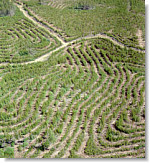4.2 Opportunities in even-aged stands
Opportunities in even-aged stands has two subheadings:
- Stand structural diversity
- Wildlife
Stand level biodiversity can be effectively managed in commercially thinned, even-aged stands by typing out areas as wildlife tree patches prior to harvesting. Blocks should be assessed for candidate areas for WTPs using some of the same criteria recommended previously for WTP selection (mix of live and dead trees of varying size, decay class and condition, species mix, and location).
In general, because of the even-aged structural character found in commercially thinned stands, current within-stand biodiversity attributes may be limited. Therefore, location (delineation) of WTPs in relative proximity to special habitat features such as riparian areas; upland hardwood habitats; gullies and rock outcrops; marshy or other wet areas; and avalanche tracks will optimize the ecological value of the patch. This will retain the variety associated with edge conditions.
Various options for artificial wildlife tree creation (e.g., tree-topping, fungal inoculation, nest boxes) can be employed in thinned stands to improve stand structural diversity and habitat quality.
For more information, see
What else can you add to this information?
Stand structural diversity
In a managed stand, the biodiversity considerations specified in a silviculture prescription should focus on maintenance of structural diversity (usually buffer strips and reserves) brought forward from the spaced stand and/or the previous harvest treatment (see Figure 14, below).

Stand structural diversity in unmanaged stands may require more creative solutions, and consultations with WLAP staff, to develop appropriate diversity. Structural diversity can be enhanced through various management practices (e.g., leaving a portion of the block unthinned). Riparian zones and buffers may partially achieve such an objective. Wet areas within blocks may be left unthinned primarily in consideration of trafficabilty. In addition, thinning areas of the block to less than target density can create openings. Planning for root rot treatments and salvage can create some openings. If there are reforestation objectives for the openings, normal silviculture prescription requirements apply. These areas can be valuable additions to a block's structural diversity.
Stand manipulations can include:
- Variation in density so some trees have sufficient room to form large, full crowns and other areas are left as thickets
- Growing larger diameter trees and leaving more openings
- Continued stocking control to maintain an open canopy which will provide for forage
- Future retention areas may be best heavily spaced and thinned to promote the windfirm characteristics that will allow them to remain after heavy removal of adjacent trees in the future
Commercial thinning may be designed to delay crown closure to meet range, wildlife habitat, biodiversity or other objectives. Future retention areas should be identified for managed and unmanaged areas (see Figure 15, below). Such areas will be maintained beyond the final harvest of the current rotation. The presence of these retention areas may influence the choice of an appropriate harvesting method.

Consider the following points for structural diversity and commercial thinning:
- Insert untreated buffers to avoid large continuous areas of thinning.
- Produce small openings, where feasible, by occasionally altering the normal spacing and creating a cluster effect. This effect is common on rich coastal sites that have regenerated naturally.
- Where safe to do so, retain some standing dead trees and poorly formed wolf trees to serve as wildlife trees in the next rotation. Safety considerations may require the establishment of a no-work zone within the treatment area.
- Preserve non-merchantable understorey trees where appropriate (understorey western redcedar can be carried into the next rotation).
- Use stands with low levels of root rot infection to enhance natural openings. Natural openings in stands with low levels of root rot infection may be increased in size by removing a ring of trees (bridge trees) around the openings.
This technique may not work where Armillaria ostoyae is prevalent. If openings are desired in a stand where root disease is prevalent, no action need be taken.
- Retain the occasional thicket of small trees (e.g., shade-tolerant under-storey Hw).
- Avoid sensitive wet sites (see Figure 16).
- Retain species mixtures if ecologically suited.
- Retain species such as western redcedar, red alder and big leaf maple that may enhance soil productivity.
- Retain large deadwood.
- Retain hardwoods that are not significant competitors to crop trees.
- Retain hardwoods to meet other management objectives.
What other stand manipulations can you add?
Wildlife
Favourable conditions for wildlife can be promoted by:
- Avoiding continuous overstocked conditions that reduce forage
- Developing structural diversity by encouraging understorey development. This can provide security cover for ungulates
- Identifying and reserving wildlife trees, deciduous trees and thickets
- Varying stand density and identifying untreated buffer zones within a stand
- Revegetating disturbed areas (landings, cutbanks, temporary roads) following harvesting
- Maintaining visual buffers with no thinning along roads with frequent use




